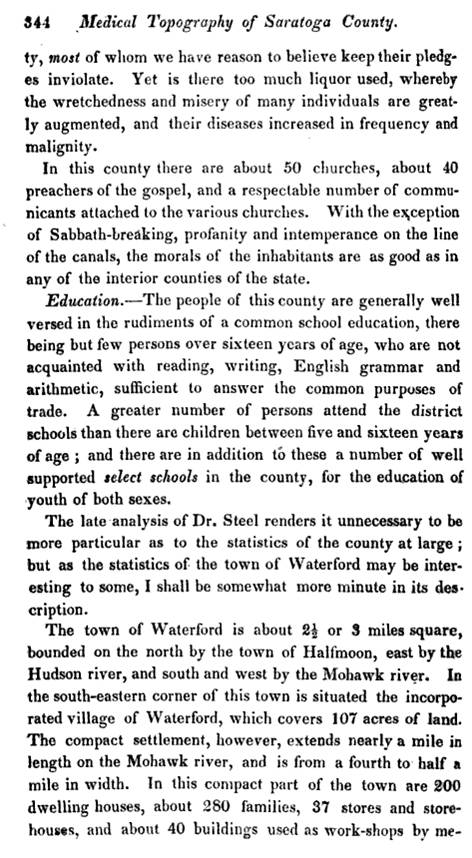.
For any historical medical geographer interested in early 19th century traditions, Saratoga is one of the more important counties to review. (A report of medical geography for its earlier years was produced as well – link.) Its uniqueness of course relates to its thermal mineral springs. The natural production of thermal waters and waters rich in alkaline materials, sulphur, various salts and minerals has always been important to physicians. The most traditional of these natural resources are the spring of Epsom that produced Epsom salts and Glauber responsible for Glauber’s Salt. Both of these salts have been standards in the apothecary for centuries if not a millenium or two. A popular goal since the first migrations into this country has been the discovery of less expensive substitutes for these famous imported goods. Saratoga County, due to its rich history linked to these springs, is one of the first counties in the New World to accomplish this feat.
Important items noted in this report are as follows:
- The authors of this work offer some very personal and subjective insights into the culture of this region, regarding drinking and behaviors on the day of the Sabbath.
- The authors are proud of the region’s development in the town of Waterford near Cohoes Falls
- The formation of the Saratoga Medical Society in 1812 is detailed.
- This report also provides us with very important details about the philosophies being practiced, mentioning “Cullen and Thomas” and traditional, perhaps even pre-1800 traditions, followed by the teachings and additions to these two made by Good and Broussais. The first referral is to William Cullen, the solidist, who believed in the role of organs in generating disease, as opposed to the older humours theory and interactive with the ongoing alkaline theory for disease out there. Thomas has yet to be identified, but may be a reference to an author and editor of a book (in my library somewhere) published around 1800-1812 on fevers, climate and geography. John Mason Good was a writer who discussed the animalcule and a version of the nervous energy-vital force theory (see two items below). François-Joseph-Victor Broussais was into the independence of organs and their abilities to interact, a popularization of the sympathetic nervous system.
- The authors (unidentified) offered some really valuable, direct insight into those first years of the development of a village or town, by discussing the place in terms of diseases from the 1790s on, with details on earlier “cholera epidemics” to strike this area. The Asiatic Cholera had stricken the states during the years immediately prior to this writing. The traditional cholera and Asiatic cholera had not yet distinguished from one another. Due to this nature of the belief about cholera for the time, we get a feeling about how the doctors were trying to link cholera in general to the world around them.
In terms of early American medical philosophy, this is a very important example of how the medical geographers were trying to make sense of disease and people. One of the more important issues during the 1830s pertained to the concept of animalcules and disease, an extension of the germ theory (which included viruses) and a predecessor to the bacterial theory. The county’s mention of British doctor, natural historian and natural philosopher, John Mason Good (who died in 1827) perhaps refers to its support of this philosophy, but might also relate to Good’s leaning towards some vital force related theory. The 1830s mark a time when homeopathy would become popular in the U.S. Its founder, Samuel Hahnemann, expressed several times the parallels his philosophy draws between extremely minute animalcules or “invisible insects” and his atom-based, or vital spark or energy like philosophy used to argue his claims about homeopathic medicines.
In the following article from England that mentions Good, any of these philosophies could have been included in the explanation for a chronically hyperglycemic diabetic’s end stage resulting in a relatively rapid death. Believers in Cullen and Broussais residing in Saratoga might have blamed this death on the affected organ (Cullen) or organs (both). Cullenites would claim that the organs are afflicted sequentially, Broussais’s followers would consider these different organs to be afflicted together or in some specific sequence with each other, causing one problem after another, leading to blindness over time as the nerves and brain become involved and no longer work in sympathy. Thomas’s followers strongly believed in climate as a cause, with human behaviors related to exercise, food and drink consumption, rest, temperament, etc. serving as initiators and making the disease worse and deadly. Good added the microscopic (invisible) animalcule touch to Thomas’s writings, and reminded the Saratoga physicians about the powers of nature, in particular those linked to nature, tempest storms, solar and perhaps lunar events, and the electric nature of the human body due to its vital spark.
Boston Med Surg J 1829; 2:726-728. Dec. 29, 1829. ‘Sketches of Periodical Literature’ Accessed at http://www.nejm.org/doi/full/10.1056/NEJM182912290024605
The Biographical Treasury; a Dictionary of Universal Biography: . . . 1831. By Samuel Maunder [LINK]
.
********************************************************
.
.
.
.
.
.
.
.
.
.








Leave a comment